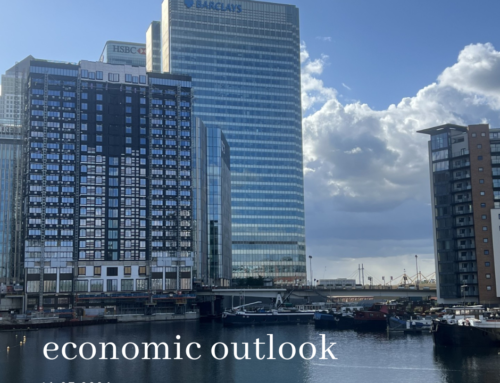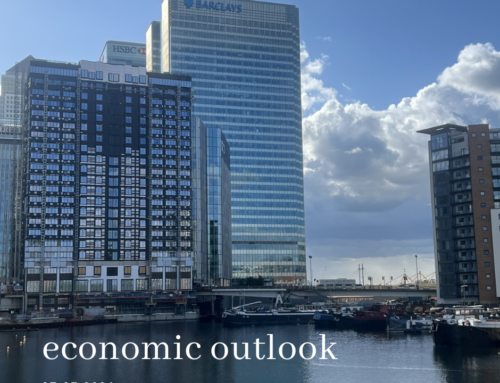| USA First-time claims for unemployment insurance rose by 22K to 231K in the week ended May 4. That was not only more than the 212K figure consensus had baked-in, it also marks the highest level since August. Yet even at a nine-month high, the claims numbers are still low by historical standards. To smooth the weekly volatility, a four-week moving average rose only 5K to 215K. Continuing claims, the number of people remaining on jobless benefits from prior weeks, posted a gain of 17K in the week ended April 27, to reach 1785K Consumer sentiment in May was downright gloomy. The index dropped 9.8 points to 67.4 in May’s preliminary reading. This accounts for the largest one-month drop in the measure since August 2021, when the emergence of the Delta variant of COVID had sentiment in shambles. Most concerning for the Fed was the jump in year-ahead inflation expectations to 3.5% in May from 3.2% a month prior, the highest short-term expectations have been since November 2023. Longer-term inflation expectations also rose a touch to 3.1%, also the highest since November 2023. These increases may reflect some price-fatigue among consumers as they recognize that progress on inflation has stagnated. And this gives the Fed yet more worrying data points to consider as it seeks to bring inflation down to target The updated Federal Reserve Senior Loan Officer Opinion Survey (SLOOS) was released for the first quarter. Survey responses showed that banks continued to tighten lending standards and report weaker demand for loans across all business and consumer loan categories. Relative to the fourth quarter of 2023, more banks tightened lending standards for consumer credit, fewer tightened commercial and residential real estate credit, and roughly the same number of banks tightened commercial & industrial credit. Within consumer credit, tighter lending standards pushed the net share of banks reporting stronger demand for credit cards to its lowest level since mid-2020 Looking at the monthly breakdown for consumer credit, the March data showed consumer credit growth decelerated considerably through the first quarter as interest rates trended higher. While consumer credit still expanded 3.2% (annualized) in the first quarter, the gains were largely front-loaded in the earlier months and tapered off as financial conditions tightened. With interest rates continuing to push higher through the first half of the second quarter, it seems likely that a further softening in consumer credit growth will occur over the coming months. Combined with depleted pandemic excess savings, weakening consumer credit growth is expected to lead to moderating consumption growth in 2024. While this should aid the Federal Reserve in their attempts to return inflation to their 2% target, officials emphasized their vigilance in recent remarks What with elevated prices, high mortgage rates and difficulty saving money for a down payment, only about four in 10 renters think they will be able to buy a home, according to a survey released by the Federal Reserve Bank of New York on Monday. That’s the lowest level since the survey on the housing-related experiences and expectations of consumers was started a decade ago Vice Chair and New York Fed President John Williams noted this week that monetary “policy is in a very good place, and we have the time to collect more [data], so steady as she goes”. This sentiment was echoed by Richmond Fed President Barkin who stated his optimism that “today’s restrictive level of rates can take the edge off demand in order to bring inflation back to our target”. Most members noted that they did not expect further policy tightening to be necessary, with Minneapolis Fed President Kashkari stating that “the bar for us raising is quite high, but it’s not infinite”. While the prospect for higher rates is unlikely at this time, Fed officials are expected to remain vigilant against the potential for upside risks to inflation. The S&P 500 Index neared its all-time high and recorded its third consecutive week of gains. The other major indexes also advanced, with value stocks generally outperforming growth shares. Market volumes were especially low over much of the week, however, with Wednesday marking the lowest notional (in terms of the value of shares traded) session of the year and its third-lightest volume (in terms of number of shares traded) session. The quiet trading week appeared to reflect a generally light and unsurprising economic calendar, although some individual stocks moved sharply in reply to first-quarter earnings releases. Most prominently, perhaps, Walt Disney shares fell 9.5% on Tuesday after the company beat earnings estimates but warned that subscriber growth in its online streaming business was likely to slow. Likewise, a prediction for slowing revenue growth appeared to lead to an 18.6% drop in shares of online retail platform Shopify on Wednesday In terms of data release, CPI is out on Wednesday. The trend lower in inflation was interrupted in the first quarter, fanning fears of a renewed acceleration in price growth that would encourage later and less easing from the Federal Reserve this year. Some renewed progress in April is expected, though the data will remain consistent with only a slow journey back to 2%. Consumer spending remains robust. Real personal consumption expenditures expanded at a 2.5% annualized rate in the first quarter, and after a weak start to the year, goods spending picked up later in the quarter. March retail sales came in better-than-expected, rebounding 0.7%. Some of the April sales gain will be due to higher prices, given the retail sales data are reported nominally. Many households have exhausted the savings accumulated during the pandemic and are now facing significantly higher debt costs and more subdued inflation-adjusted income growth. Spending data have continued to surprise to the upside, but households are increasingly prioritising purchases. Although volatile, non-discretionary categories have outpaced discretionary on trend for the past year. Industry comments included in Q1 earnings releases also emphasised a consumer trading down in search for value. UK GDP figures for Q1 have come though, showing the economy expanded by 0.6% QoQ, 0.2% YoY. While these figures were better than expected, they are quite far below what used to be considered “trend”, but critically they do mean the UK is no longer in recession. In expenditure terms, there were increases in the volume of net trade, household spending and government spending, partially offset by falls in investment. Real household expenditure in Q1 grew by 0.2%, following declines in the previous two quarters. There were contributions to the growth from housing, utilities, recreation, restaurants, and household goods and services. The broad basing of this growth points to an ongoing revival of consumer confidence and suggests that this trend can be expected to run for several quarters The Bank of England’s Monetary Policy Committee (MPC) held interest rates at 5.25% by a vote of 7-2. The MPC meeting in March, which also held rates at the present level, saw a vote of 8-1, with just one member voting to reduce interest rates by 25bp. That vote was most notable in there were no longer any votes to raise interest rates. The vote has seen a marginal increase in the number of members looking to reduce interest rates, although just when this will turn into a majority in favor of reducing rates is open to ongoing speculation. All eyes remain focused on inflation and the next data release (due on 22 May) which is expected to reflect the final base effect of energy prices falling as well reductions to the pace of services and goods inflation: the result inflation is forecast to move from 3.2% to 2.1%. The key will be the sustainability of a lower level of inflation The BoE signaled that an interest rate cut in June is on the table as vote for reducing rates could be important. Historically, Ramsden’s voting pattern has been a leading indicator of moves by the rest of the Monetary Policy Committee. A decision to lower borrowing costs in June is likely as long as the labor market and services inflation data in the next two months do not surprise significantly to the upside. EU Eurozone retail sales surged 0.8% in March after declining 0.3% the month before. Consensus expectations were for a 0.6% increase. This was their strongest advance in 18 months and the first time since September 2022 that retail sales progressed on an annual basis. A recovery in consumer spending is a welcome sign after a bout of economic weakness in the face of elevated interest rates. The improvement in retail spending should not necessarily delay potential action on the monetary policy front seeing how inflation has cooled and overall growth perspectives remain moderate In local currency terms, the pan-European STOXX Europe 600 Index ended 3.01% higher on better-than-expected corporate earnings and increased optimism that major central banks would soon start cutting interest rates. Major stock indexes also rose sharply. Germany’s DAX gained 4.28%, France’s CAC 40 Index put on 3.29%, and Italy’s FTSE MIB added 3.06%. CHINA China’s exports rose by 1.5% in April from a year earlier, up from a 7.5% decline in March, and broadly in line with consensus estimates. Exports to Southeast Asian nations improved, while European shipments fell. Sales to the U.S. were little changed. Imports climbed a better-than-expected 8.4% in April, reversing March’s 1.9% decline, which some analysts attributed to increased raw materials shipments rather than improved consumer demand. The overall trade surplus increased to USD 72.35 billion, up from USD 58.55 billion in March The private Caixin/S&P Global survey of services activity reached 52.5 in April, down from March’s 52.7, as expected, and marked its 16th monthly expansion. Readings above 50 indicate an expansion from the prior month. The Caixin/S&P composite purchasing managers’ index, which tracks both the services and manufacturing sectors, edged up to 52.8 from 52.7 in March as overall business activity expanded in April Tourism revenue over the five-day break rose 7.6% compared with the 2023 holiday and surpassed pre-pandemic levels, according to data from the Ministry of Culture and Tourism. Domestic revenue rose 12.7% from last year, while international trips also picked up. Box-office sales reached RMB 1.53 billion, roughly in line with the prior year. However, average spending per traveler fell 11.5% from 2019 as consumers remained cautious about spending Chinese stocks advanced as recovery hopes rose following buoyant holiday spending during the prior week’s Labor Day holiday. The Shanghai Composite Index rose 1.6%, while the blue-chip CSI 300 gained 1.72%. In Hong Kong, the benchmark Hang Seng Index added 2.64%. |
| Sources: T. Rowe Price, MFS Investments, Wells Fargo, Handelsbanken Capital Markets, TD Economics, National Bank of Canada, M. Cassar Derjavets. |


